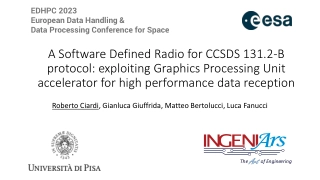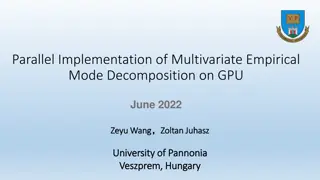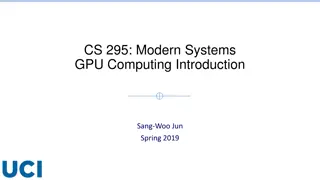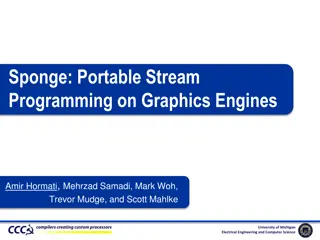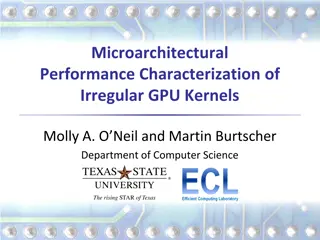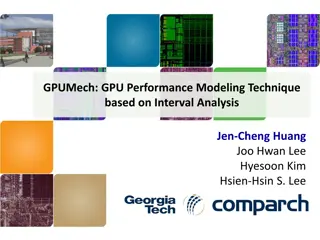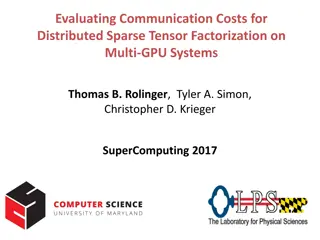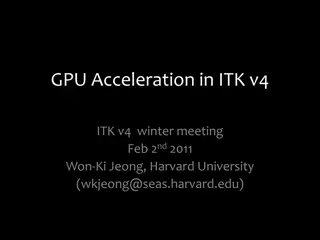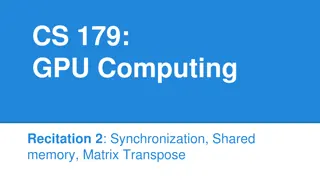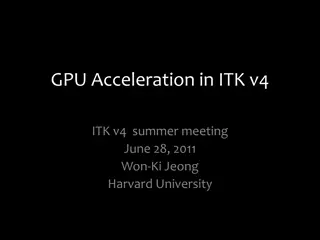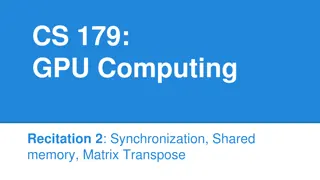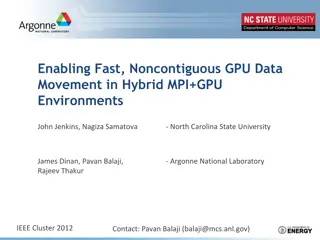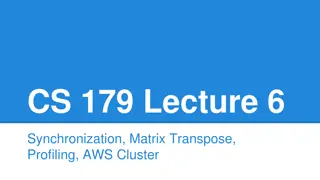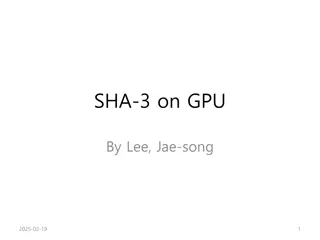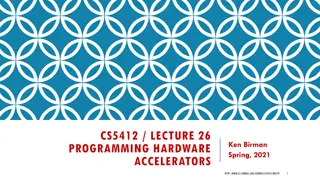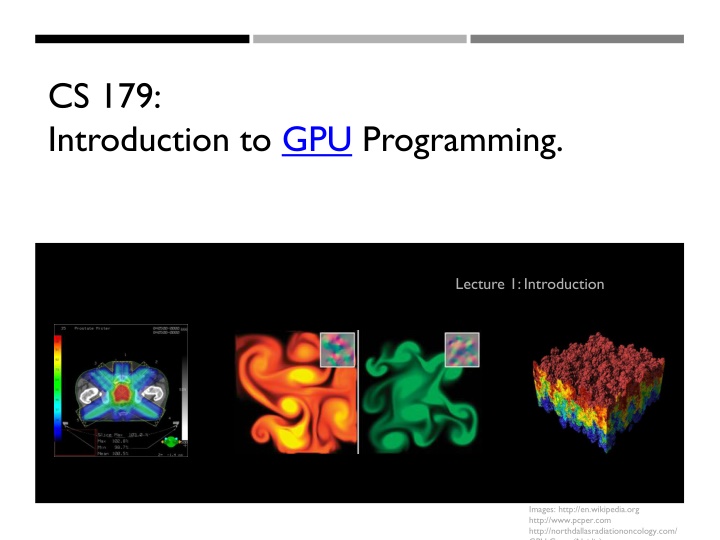
CS 179 Introduction to GPU Programming - Course Overview
This course covers GPU computing, parallelization, C++, CUDA, and focuses on assignments, a final project, collaboration policies, office hours, and project requirements. It also includes information on the primary websites, TA details, homework deadlines, and utilizing the Caltech GPU machine for submissions.
Download Presentation

Please find below an Image/Link to download the presentation.
The content on the website is provided AS IS for your information and personal use only. It may not be sold, licensed, or shared on other websites without obtaining consent from the author. If you encounter any issues during the download, it is possible that the publisher has removed the file from their server.
You are allowed to download the files provided on this website for personal or commercial use, subject to the condition that they are used lawfully. All files are the property of their respective owners.
The content on the website is provided AS IS for your information and personal use only. It may not be sold, licensed, or shared on other websites without obtaining consent from the author.
E N D
Presentation Transcript
CS 179: Introduction to GPU Programming. Lecture 1: Introduction Images: http://en.wikipedia.org http://www.pcper.com http://northdallasradiationoncology.com/ GPU Gems (Nvidia)
Administration Main topics covered in course: (GP)GPU computing/parallelization C++ CUDA (parallel computing platform) TAs: Thomas Barrett (Head TA) (tbarrett@caltech.edu) Michael Valverde (michael@caltech.edu) Mario Ruiz (mjruiz@ca.tech.edu) TBA Overseeing Instructor: Al Barr (barr@cms.caltech.edu) .
Primary Websites: http://courses.cms.caltech.edu/cs179/ http://www.piazza.com/caltech/spring2022/cs179 Piazza is the primary forum for the course! Make sure you re enrolled! Also CS179 Canvas Calendar Class time: MW(F) 3pm PDT for classes and HW recitations. Also TA office hours, some through Zoom (TBA)
Course Requirements Homework: 6 assignments, in 6 weeks. Each worth 10% of grade Also enough work before Add Day, to pass! Final project: 4-week project 40% of grade total P/F Students must receive at least 60% on every assignment AND the final project.
Homework Due on Tuesdays 3PM PDT. First set is due Tuesday April 5th Use zip on remote GPU computer in Barr lab to submit HW. Collaboration policy: Discuss ideas and strategies freely, but all code must be your own Do NOT look up prior years solutions or reference solution code from github without prior TA approval Use additional backup method for work, on a different computer. Make your github repository *Private*! Office Hours: Most will be in person, some through Zoom. Times: TBA Extensions Ask a TA for one if you have a valid reason See main website for details.
Your GPU Project Project can be a topic of your choice We will also provide many options Teams of up to 2 people 2-person teams will be held to higher expectations Requirements Project Proposal Progress report(s) and Final Presentation More info later
Caltech Machine and your accounts now available. The Primary GPU machine is set up and available You will soon receive a user account in email. Please test access and change your password. GPU-enabled machine is on the Caltech campus. Let us know if you have problems! You ll be submitting HW on this computer.
Alternative GPU Machines Alternative: Use your own machine. You will still have to submit and test HW on the Caltech GPU machine. Must have an NVIDIA CUDA-capable GPU At least Compute 3.0 Virtual machines generally won t work Exception: Machines with I/O MMU virtualization and certain GPUs Special requirements for: Hybrid/Optimus systems (laptops) Mac/OS X (probably no longer supported?) Setup guide on the website is likely outdated. Can follow NVIDIA s posted installation instructions (linked on page). Ubuntu 22.04 or later ay be easiest to install!
The CPU The Central Processing Unit Traditionally, applications use CPU for primary calculations General-purpose capabilities, mostly sequential operations Established technology Usually equipped with 8 or fewer, powerful cores Optimal for some types of concurrent processes but not large scale parallel computations Wikimedia commons: Intel_CPU_Pentium_4_640_Prescott_bottom.jpg
The GPU The "Graphics Processing Unit" Relatively new technology designed for parallelizable problems Initially created specifically for graphics Became more capable of general computations Very fast and powerful, computationally Uses lots of electrical power
GPUs Some of the Motivation Raytracing: for all pixels (i,j) in image: From camera eye point, calculate ray point and direction in 3d space if ray intersects object: calculate lighting at closest object point store color of (i,j) Assemble into image file Superquadric Cylinders, exponent 0.1, yellow glass balls, Barr, 1981 Each pixel could be computed simultaneously, with enough parallelism!
SIMPLE EXAMPLE Add two arrays, A and B to produce array C A[ ] + B[ ] -> C[ ] On the CPU: float *C = malloc(N * sizeof(float)); for (int i = 0; i < N; i++) C[i] = A[i] + B[i]; return C; On CPUs the above code operates sequentially, but can we do better, still on CPUs?
A simple problem On the CPU (multi-threaded, pseudocode): (allocate memory for array C) Create # of threads equal to number of cores on processor (around 2, 4, perhaps 8?) (Indicate portions of arrays A, B, C to each thread...) ... In each thread, For (i from beginning region of thread) C[i] <- A[i] + B[i] //lots of waiting involved for memory reads, writes, ... Wait for threads to synchronize... This is slightly faster 2-8x (can be slightly more with other tricks)
A simple problem How many threads are available on the CPUs? How can the performance scale with thread count? (Each CPU can generally have two threads). Context switching: The action of switching which thread is being processed High penalty on the CPU (main computer) Not a big issue on the GPU
A simple problem On the GPU: (allocate memory for arrays A, B, C on GPU) Create the kernel where each thread will perform one (or a few) additions Specify the following kernel operation: For all i s (indices) assigned to this thread: C[i] <- A[i] + B[i] Start ~20000 (!) 20000 (!) threads all at the same time! Wait for threads to synchronize...
GPU: Strengths Revealed Emphasis on parallelism on GPUs means we have lots of cores This allows us to run many threads simultaneously with virtually no context switches
GPUs Brief History Initially based on graphics focused fixed-function pipelines (history) Pre-set pixel/vertex functions, limited options http://gamedevelopment.tutsplus.com/articles/the-end-of- fixed-function-rendering-pipelines-and-how-to-move-on-- cms-21469 Source: Super Mario 64, by Nintendo
GPUs Brief History Shaders Can implement one s own functions using graphics routines. GLSL (C-like language), discussed in CS 171 Can sneak in general-purpose programming! Uses pixel and vertex operations instead of general purpose code. Very crude. Vulkan/OpenCL is the modern multiplatform general purpose GPU compute system, but we won t be covering it in this course http://minecraftsix.com/glsl-shaders-mod/
Using GPUs as supercomputers General-purpose computing on GPUs (GPGPU) Hardware has gotten good enough to a point where it s basically having a mini-supercomputer CUDA (Compute Unified Device Architecture) General-purpose parallel computing platform for NVIDIA GPUs Vulkan/OpenCL (Open Computing Language) General heterogenous computing framework Both are accessible as extensions to various languages If you re into python, checkout Theano, pyCUDA. Upcoming GPU programming environment: Julia Language
GPU Computing: Step by Step Setup inputs on the host (CPU-accessible memory) Allocate memory for outputs on the host CPU Allocate memory for inputs on the GPU Allocate memory for outputs on the GPU Copy inputs from host to GPU (slow) Start GPU kernel (function that executes on gpu fast!) Copy output from GPU to host (slow) NOTE: Copying can be asynchronous, and unified memory management is available
The Kernel This is our parallel function Given to each thread Simple example, implementation:
Indexing Can get a block ID and thread ID within the block: Unique thread ID! https://cs.calvin.edu/courses/cs/374/CUDA/CUDA-Thread-Indexing-Cheatsheet.pdf https://en.wikipedia.org/wiki/Thread_block
GPU Computing Examples Solving PDEs on GPUs GPU vs CPU fluid mechanics Ray Traced Quaternion fractals and Julia Sets Deep Learning and GPUs Real-Time Signal Processing with GPUs
Questions can be live and interactive, on Zoom during office hours. Also can be posted on Piazza.

